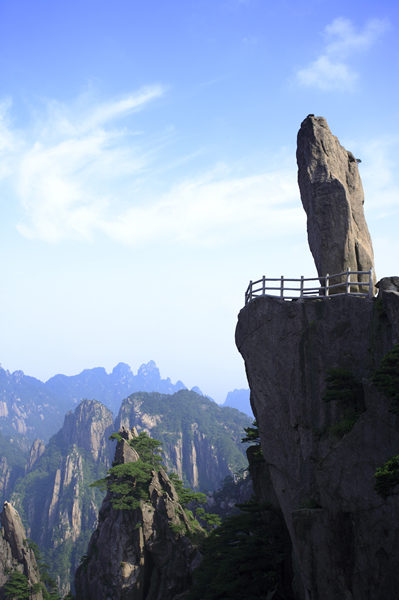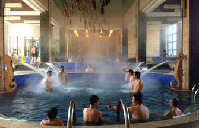A sight for sore thighs
 |
|
Flying Over Rock is a famous site on Mount Huangshan. Photo provided to China Daily |
Paved with stone stairs and embraced by plants and rocks, the route for last weekend's competition stretched for 12 km and ended 1,900 meters above sea level. There are steep gradients and a leisurely plateau, making it easier than a relentless vertical ascent but harder than a treadmill jog. However, while simply throwing my hat in the ring felt like a rite of passage and a major accomplishment, the climb also represented a crucial lung-cleansing ritual. People who live in polluted urban centers need to take advantage of such opportunities.
Chinese are becoming increasingly health-conscious and recent photos from Harbin and Beijing reminds them of the smog-filled perils of big-city life. Instead of questioning just how valuable jogging outside is in such car-clogged metropolises, it might be easier to head to places like Huangshan every few months to suck up lungful after lungful of their remarkably clean air.
In fact, similar competitions can be found year-round. Similar races are organized annually at Yunnan province's snowcapped mountains, as well as at the five sacred mountains of Taishan in Shandong, Huashan in Shaanxi, Hengshan in Shanxi, Songshan in Henan and Hengshan in Hunan.
There are many routes to choose from when ascending Huangshan, but I think the one along the Xihai Grand Canyon is the best choice. Every step seems to open up a staggering new vista, as well as the adrenal thrill of walking so close to a vertical precipice.
A 4.5-km downhill trek leads deep into a ravine and ends at Fairy-Walking Bridge. This is followed by a demanding 3-km uphill march that heads to two more landmarks with poetic Chinese names: White Cloud Sea and Heavenly Sea. Another 700-meter climb ends at Bright Summit, after which it is an easy 1-km descent to Flying-Over Rock. The final 1.5 km circles back to Cloud-Dispelling Pavilion.
Meanwhile, there is a cablecar station at the bottom of the canyon for those who would rather call it a day halfway through and pay 80 yuan ($13). I'd like to say I manned up and braved my way through the whole course, but honestly, that was probably the most enjoyable cable car ride my jellified legs had ever experienced.
Autumn or early winter is considered the best time to visit Huangshan for those planning a timed ascent as the temperature and humidity is most conducive. It is advisable to pack water and energy bars beforehand as those sold on the mountain are predictably pricey. Walking sticks are much more affordable, and can be purchased at the start of the course for 5 yuan. Accommodation on the mountain itself ranges from 1,500 to 2,000 yuan, so most people limit their trip on the mountain to one day and stay in hotels at the foothills.
If you go:
Longhaul buses set out every day from the bus station right next to the Shanghai Railway Station, and stops around six hours later at Huangshan city. Shanghai Airlines runs one flight a day that leaves Shanghai at 2:30 pm, but the price varies greatly depending on the season and time of booking. A taxi from Huangshan Tunxi International Airport to Huangshan Bus Station costs around 10 yuan. Take a shuttle bus there for 16 yuan to the south gate of Huangshan Scenery Park.
















